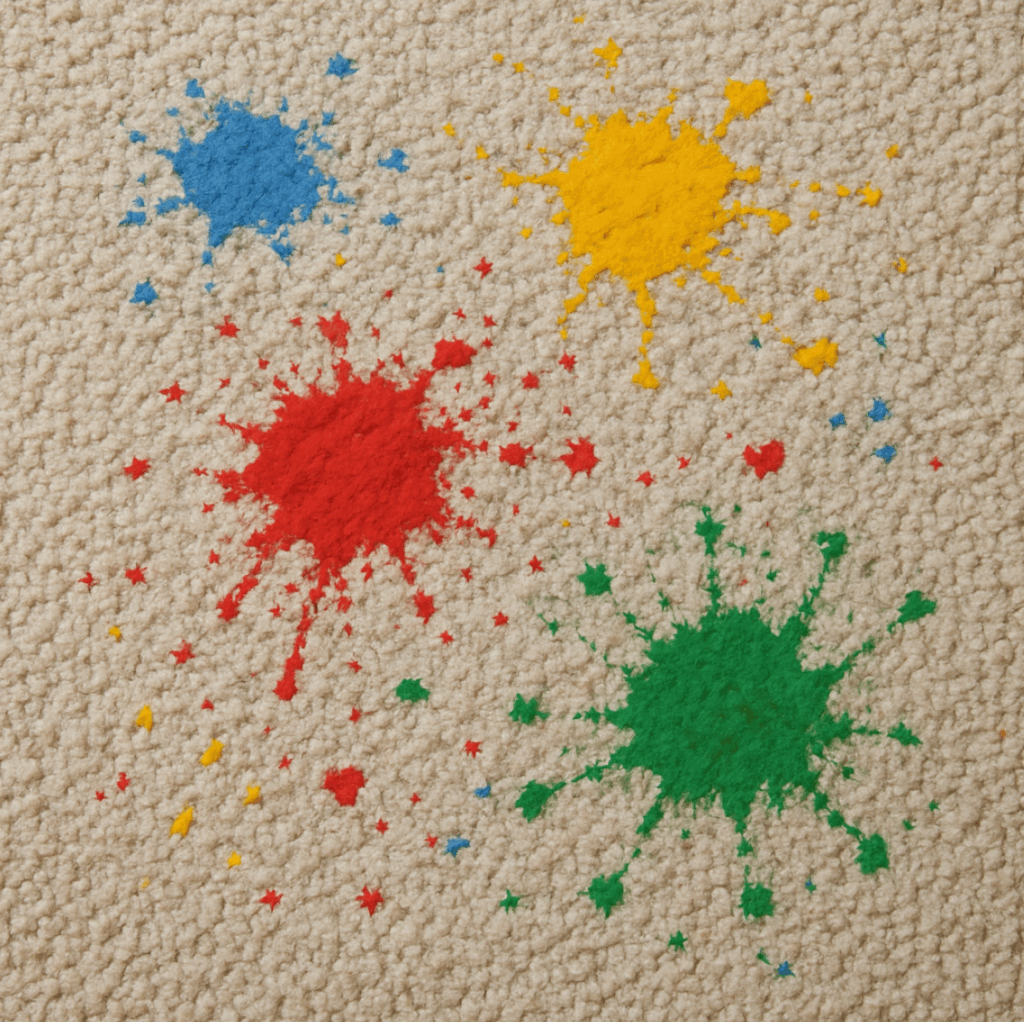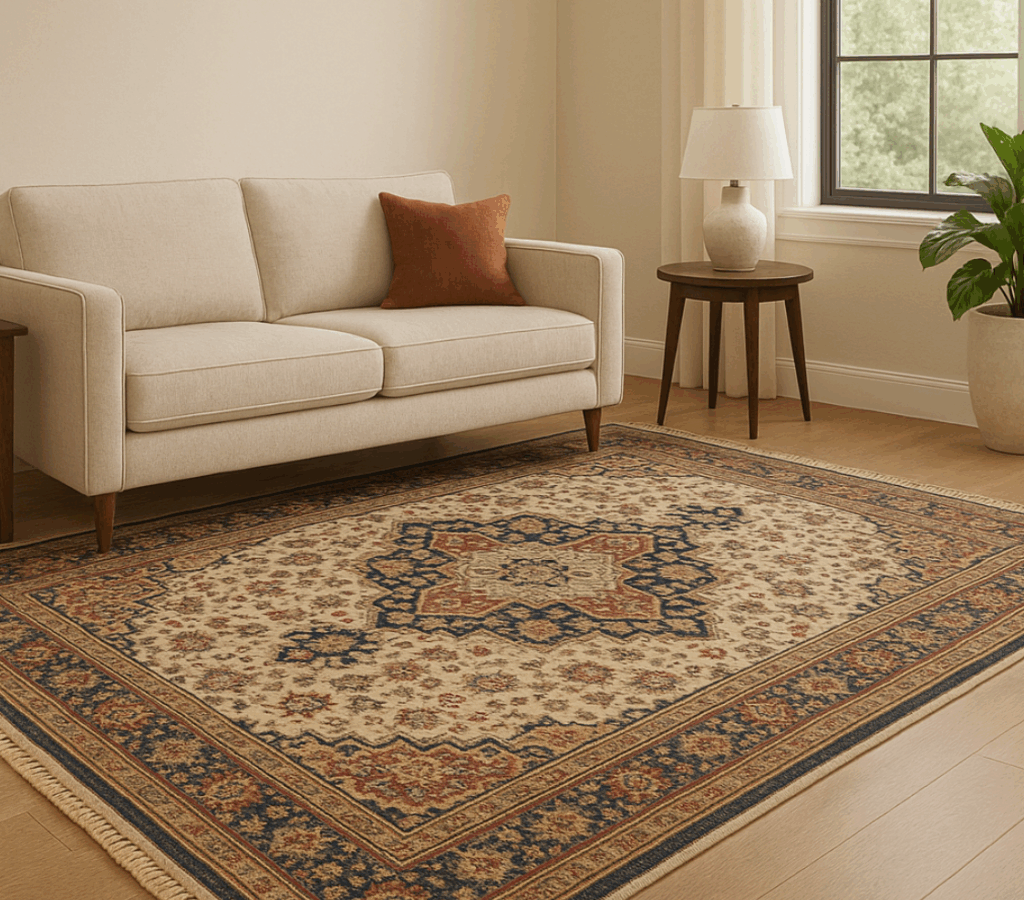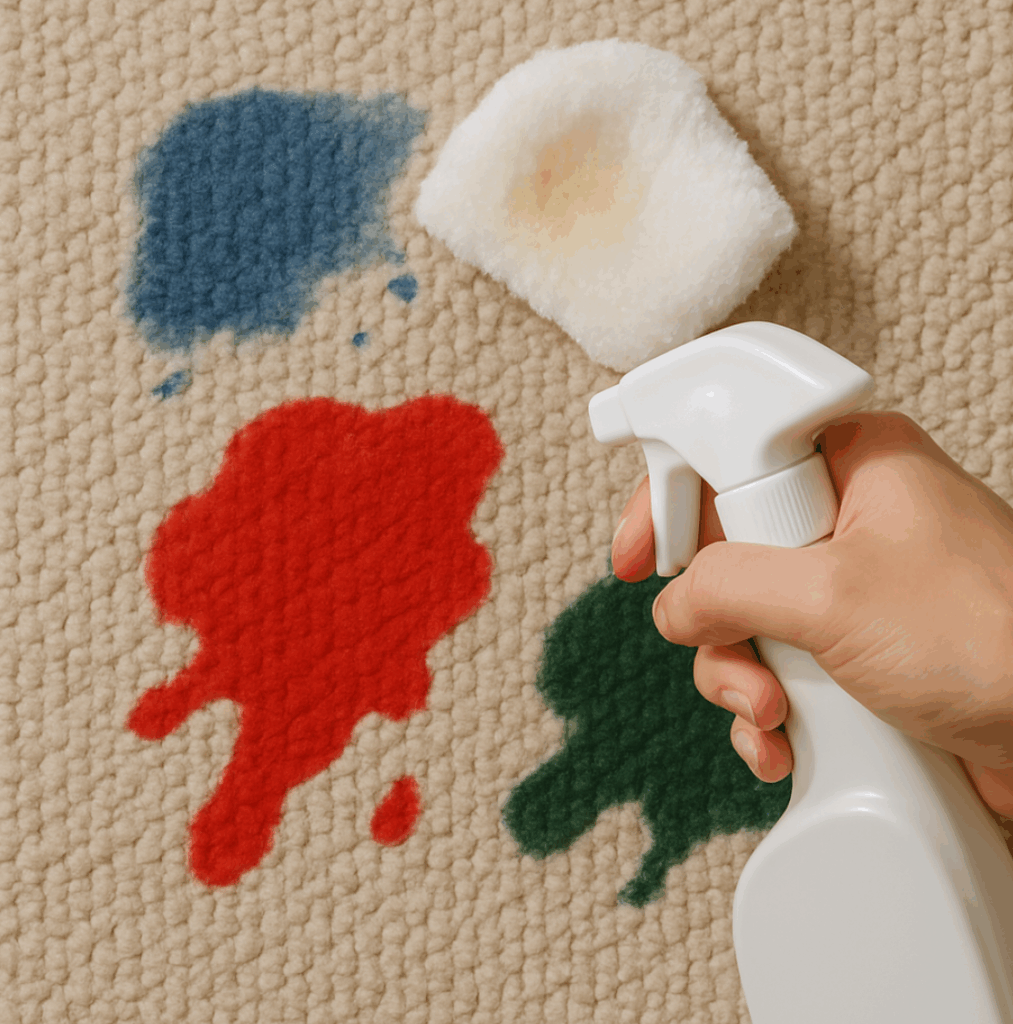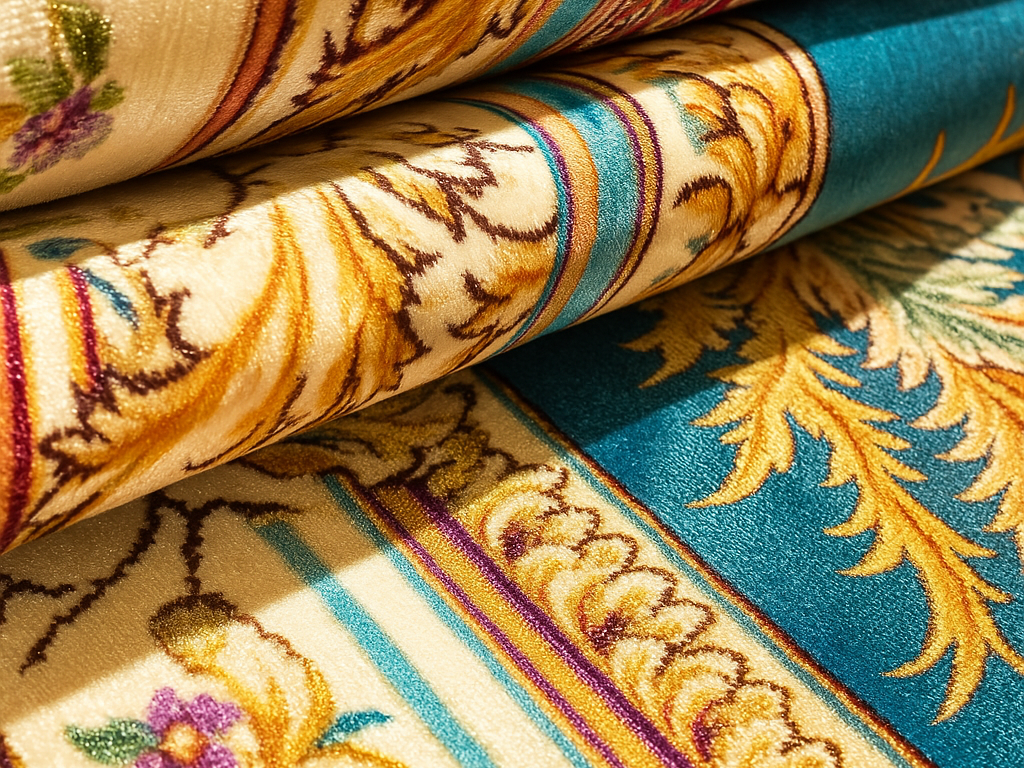ウールラグはどんな部屋にも暖かさと質感、そして時代を超越したエレガンスのユニークな融合をもたらします。合成繊維の床材とは異なり、ウールはその豊かな色合い、ふっくらとした手触り、構造的な完全性を維持するために、優しくも戦略的なクリーニングが必要です。日常的な足の動き、突然の食べこぼし、頑固なシミなど、ウールのお手入れ方法を知っていれば、どんな状況にも対応できます。 ウールラグのクリーニング方法 適切な処置を施すことで、時間や費用、そして繊維がダメになってしまうという心の傷を軽減することができるのだ。

この包括的なガイドでは、日常のお手入れとスポット清掃に始まり、ディープクリーニングのテクニック、そしてシミ抜き、防臭、害虫予防に至るまで、完全なメンテナンス方法をご紹介します。
信頼できる情報源から得た専門的な方法と実際の経験をもとに、ラグの寿命を延ばし、美しさを保ち、ご自宅を最高の状態に保つための知識を身につけていただくことを目的としています。さっそく、ウールへの投資を正しい方法で育てていきましょう。
1.ウールラグの適切なクリーニングが重要な理由
ウールは天然で贅沢な繊維で、どんな空間にも暖かさと深みをもたらします。丁寧な手入れがなければ、 ウールラグ は、くすんだり、縮んだり、染料の鮮やかさが失われたり、傷んだりすることがあります。適切なクリーニング
- 鮮やかさと質感を保つ。 ウール繊維は染料を非常によく保持しますが、清潔な場合に限ります。定期的なお手入れは、色をくすませる残留物の蓄積を防ぎます。
- 耐久性を守る。 ウール繊維は、不適切な洗剤や熱湯、過湿にさらされると縮んだり、マットになったり、劣化したりします。
- 健康被害を防ぐ。 汚れ、皮脂、ペットのフケ、ウール繊維に閉じ込められた湿気は、カビやバクテリア、臭いの原因となる微生物を繁殖させる可能性がある。
- 害虫を寄せ付けない。 汚れや有機ゴミは、蛾やカーペット・カブトムシを引き寄せる。
手入れが行き届いたウールラグは何十年も、アンティークの手織りの場合は何百年も使うことができます。
関連記事 ラグは家具とみなされるか?インテリアデザインの完全な内訳
2. ウールラグの日常ケアと週1回のお手入れ
ウールラグはホコリ、ゴミ、アレルゲン、髪の毛の天然の磁石です。そのままにしておくと、これらの粒子が深く入り込み、繊維をすり減らし、色をくすませ、構造の完全性を損ないます。ホコリやアレルゲンは室内の空気の質にも影響を与えます。定期的で優しいクリーニングは、単に美観を保つだけでなく、長持ちさせ、衛生的に保つために不可欠です。

掃除機をかける最前線の防御
| ロケーションタイプ | 推奨頻度 |
| 交通量の多い場所 | 週1~3回(リビングルーム、廊下など) |
| 適度な交通量の部屋 | 週1回の掃除機がけで十分 |
| 人通りの少ない場所 | 隔週または毎月 |
- アレルギーの季節、接待の後、ペットを飼っている場合などは、毎日のケアが必要になる。
優しいクリーニングのベストプラクティス
- 吸引専用掃除機 (繊維のほつれを防ぐには、ビーターバーなし)またはソフトブラシのアタッチメントが理想的です。
- の真空 仮眠の方向 (ファイバー・アライメント)。
- 用途 軽く、重なるストロークそして、ブラシや椅子張り用アタッチメントを使って、エッジやフリンジの上を掃除する。
- をお忘れなく。 下側-時々、裏返しにして掃除機をかけ、ホコリを取り除く。
震えまたは叩き
月に1回(または掃除機をかける前)、ラグを外に出し、手すりや物干し竿にかけておく:
- 軽く シェイク 表面のホコリを取り除く。
- を使用する。 ラグビーター またはテニスラケットで背中を軽く叩き、ゴミを取り除く。
スポット清掃とブラッシング
- 毎日のタッチアップ: マイクロファイバー製のダストモップや柔らかいほうきを使って、緩んだ汚れを素早く浮き上がらせる。
- パイルリフレッシュ: 絨毯が平らだと感じたら、軽くブラッシングしてください。
定期ローテーション
ラグを180度回転させる 3~6カ月.これによって、被曝量が均等化される:
- 人通りが多い: 集中ゾーンでの摩耗を軽減。
- 太陽の光だ: 染料の退色ムラを防ぐ。
ラグパッドの重要性
品質 ラグパッド を提供する:
- ラグの下にクッションを追加。
- 摩擦によるダメージからの保護。
- スリップを防ぐトラクション強化。
専門家は、長持ちさせるために、特にウールラグの下にパッドを使うことを強く勧めています。
シューズ・フリーゾーンとトラフィック・マネジメント
- 奨励する ノーシューズポリシー特に人通りの多い場所やダイニングエリアでは。
- 使用頻度の高いゾーンからラグを離すか、耐久性の高いラグを使用する。 ランナー 廊下や玄関に敷いて、ウールのラグを保護する。
季節調整
- アレルギーの季節だ: 絨毯は、掃除機の頻度やビーターの使用量を増やすとよいでしょう。
- 泥の季節(雨/雪): 湿った履物は玄関で拭き、泥は速やかに掃除機で吸い取る。
関連記事 ラグのコーヒーの染み抜き方法:プロフェッショナルガイド
3. ウールラグの即時スポットクリーニング
食べこぼしやアクシデントに対処するには、迅速な行動が重要です。ウールのラノリンオイルはシミになりにくいのですが、水分や顔料、油分を長く放置しておくと繊維に染み込んでしまうことがあります。対応が早ければ早いほど、永久的なシミや繊維の損傷を防ぐことが容易になります。

必要なもの
緊急時のスポット清掃用に、これらのアイテムを用意しておこう:
- 清潔な白い綿布またはペーパータオル (移染する可能性のあるインクや染料は避ける)
- ウールに安全な中性洗剤または酵素クリーナー (ウールクリーンやウールライトのような)
- 冷水からぬるま湯 (繊維の収縮や染料のにじみを防ぐ)
- 蒸留白酢 消臭・色素コントロール用
- 柔らかいブラシまたはスポンジ 頑固なスポットを優しく攪拌する
ステップ・バイ・ステップ スポット・クリーニング・ガイド
ステップ1:余分な固形物を取り除く
固形物(泥、食べ物、嘔吐物)は、繊維を傷つけないようにスプーンや鈍いナイフですくい上げる。
ステップ2:こすらず、しみこませる
食べこぼしはすぐに清潔な白い布でふき取って水分を吸収させます。こするとシミが深くなり、繊維を傷めることがあります。
ステップ3:洗浄液の準備
タンパク質や水性の汚れには、ぬるま湯1カップにウール用洗剤(または透明な食器用洗剤)を小さじ1杯混ぜる。汚れや臭いが強い場合は、ホワイトビネガーと水を同量混ぜます。
ステップ4:隠しエリアのテスト
色のにじみや生地の変形がないことを確認するため、必ず目立たないコーナーでパッチテストを行ってください。
ステップ5:溶液を優しく塗る
布かスポンジを湿らせ、シミが広がらないよう、端から中央に向かって軽く叩く。1~2分放置する。
ステップ6:すすぎと再ブロッティング
新しい湿らせた布で洗剤の残留物を洗い流す。水滴が見えなくなるまで拭き取る。
ステップ7:丁寧に乾かす
乾いた布かペーパータオルで水分を拭き取る。熱を避ける。必要に応じて扇風機を使い、平干しする。ウールを縮ませるスチームや熱器具は避ける。
ステップ8:毛羽立たせる
乾いたら、起毛(パイル)方向に優しくブラッシングし、風合いと膨らみを取り戻す。
一般的な汚れのクリーニング
| 染色タイプ | 最高のDIYソリューション |
| 液体(ジュース、コーヒーなど) | すぐに拭き取り、中性洗剤を混ぜて使う。頑固な色素には、酢と水を混ぜた洗剤を使う。 |
| グリース/オイル | マイルドな食器用洗剤+水で、軽くたたき、よくすすぐ。浸け置きは避ける。 |
| 泥 | 乾燥させ、固形物をこすり落とし、濡れた残留物を洗剤溶液で処理する。 |
| ワイン/ラスト | 酢水を塗布し、拭き取る。掃除の後、重曹を振りかけると吸収される。 |
| ペットの事故 | 酵素ベースのクリーナーは有機残留物の分解を助ける。仕上げに酢をスプレーして臭いを中和する。 |
何 違う やること
- お湯を使わない-シミを定着させ、ラグを縮ませます。
- 漂白剤、アンモニア、アルカリ性の洗剤は避ける。ウールの天然オイルを浸食し、色落ちさせる可能性がある。
- 強くこすったり、硬いブラシを使ったりしないでください。-これはウールの繊維をほつれさせ、光沢を鈍らせる。
- 電動工具とスチームクリーナーを飛ばす-熱や磨耗が強すぎると、収縮や損傷の危険性がある。
4.ウールラグのディープクリーニング

ディープクリーニングの頻度は?
ディープクリーニングは、単にリフレッシュするだけではありません。掃除機だけでは除去しきれない汚れやアレルゲンを取り除くために不可欠です。頻度は様々です:
- 6ヶ月ごと 家庭用ラグ、特に人の出入りの多い場所やペットのいる家庭で。
- 6~12カ月ごと 一般的な住宅用。
- 1~3年 鮮やかさを取り戻し、土壌の研磨剤から繊維を保護するために、専門家によるディープクリーニングをお勧めします。
- ウールは耐久性があるが、濡れ過ぎには弱い。
7ステップの専門家によるディープクリーニング・プロセス
このステップ・バイ・ステップのルーティンに従えば、長寿と美しさを保つことができる:
予習&復習 真空
- 絨毯はできれば屋外で、清潔で乾いた場所で行うのがベストです。
- 吸引専用モードまたはブラシレスアタッチメントを使用して、両面を十分に掃除機で掃除し、ゆるいゴミを取り除く。
シェイク&ビート
- 手すりや物干し竿に掛け、揺すったり、ラグビーターやテニスラケットで軽く叩いたりして、深く入り込んだホコリを取り除く。
洗浄液の塗布
- バケツに冷たい水を入れ、ウールに安全な液体洗剤またはウール専用のシャンプー(The Laundress Wool & Cashmere Shampooなど)と混ぜる。
- 繊維を保護するため、刺激の強いカーペットクリーナーや熱いお湯は避けてください。
セクション別作業
- 柔らかいブラシかスポンジを溶液に浸し、絨毯のパイルの向きを見ながら、扱いやすい部分に分けて優しくこすります。
- 汚れた部分には特に注意してください。ただし、ウールが水に浸かると繊維が弱くなり、カビが生えやすくなります。
十分にすすぐ
- 洗浄液が完全に洗い流されるまで、ホース(屋外)またはスポンジ(屋内)を使ってきれいな冷水を使用する。
- 目に見える石鹸は取り除き、汚れを引き寄せる残留物の蓄積を防ぐ。
余分な水分を取り除く
- 絨毯を絞るか、乾いたタオルで巻いて水分をできるだけ吸い取ります。
- 乾燥時間を早め、カビを防ぐことができる。
適切な乾燥
- ラグは平らに敷くか、両面を風通しの良い状態にして支柱の上に垂らします。
- 24時間以上かかる場合もある。
- 真昼の直射日光を避け、乾燥中は回転させ、色持ちを均一にする。
関連記事 ラグの臭いを消すカーペット消臭剤10選
5. ウールラグのシミ抜き方法
| 染色タイプ | ホームトリートメント | プロを呼ぶタイミング |
| コーヒー/フード | 冷水+酵素クリーナー+ブロッティング | 顔料、セットイン24時間 |
| グリース/オイル | マイルドな食器用洗剤+水で、軽くたたいてふき取る。 | ディープグリース、大面積 |
| ワイン/嘔吐 | 重曹パウダー+酢液 | 赤い染料、古いこぼれ |
| ペットの尿 | 酵素クリーナー+重曹 | 広範な被害 |
| インク/染料 | 溶剤系しみ抜き剤(ウールも使用可) | イエス・タイムが重要 |
スポットクリーナー ヒント:
- 常に パッチテスト 目立たない場所で。
- からの仕事 アウトサイド・イン 拡散を防ぐために。
- 濡らし過ぎないこと。すべての残留物を除去し、十分に乾燥させる。
6. ウールラグの臭いを取る方法
ペットのディーゼル臭や口臭など、しつこい臭いは通常、湿気やバクテリアの繁殖、使用済みのウールオイル(ラノリン)、ラテックスの裏地、食べこぼしなどから発生する。

サン&エアトリートメント
晴れて乾燥した日に、24~48時間、ラグを平らな状態にして(裏返しにして)屋外に置きます。紫外線が微生物を除去し、繊維をリフレッシュします。
重曹トリートメント
- 乾いた敷物にたっぷり振りかけ、一晩置く。
- 掃除機をよくかけ、臭いや汚れを取り除く。
- プロのアドバイス:ふるいにかける 重曹 を目の細かいふるいにかけて、軽く繊維に刷り込む。
酢スプレー
- 同量のホワイトビネガーと水を混ぜ、軽く霧吹きをする。
- 水分を吸収するためにしみ込ませ、自然乾燥させます。刺激の強い化学薬品を使わずに臭いを中和します。
オプションのエッセンシャルオイル
ラベンダー、ティーツリー、ユーカリ、ユーカリオイルを水に5~10滴たらすと、穏やかな香りと抗菌作用がアップする。
猫砂または炭の粉
臭いがひどい場合:無香料の猫砂か活性炭で24~48時間覆い、掃除機をかけるか屋外で振り払う。
ウォッカミスト(お好みで)
スプレーボトルに入った安いウォッカは、臭いを中和し、自然に消毒する。
最後のディープウォッシュ
臭いが残る場合は、再度ディープウォッシュを行い(前項を参照)、徹底的かつ安定した乾燥を行う。
7.害虫の予防蛾と甲虫
ウールは、有機オイルやゴミが原因で、カーペット・ビートルや衣類用の蛾を引き寄せる。侵入を防ぎましょう:
- 清潔さ: 定期的に掃除機をかけ、ゴミを取り除き、年2回ディープクリーニングを行う。
- 日光にさらされる: 紫外線は蛾のライフサイクルを阻害し、幼虫を抑止する。
- 保管上の注意: 無酸性ティッシュでラグを巻きます。害虫よけに、シダーブロックやラベンダーのサシェを加える。
- 定期検査: 穴、糞(小さなペレット)、幼虫や小虫が下にいないか観察する。
- 専門家による燻蒸/処理: 蔓延した場合は、専門家の助けを借りること。
8.ウールラグの定期メンテナンスチェックリスト
読者が簡単にメンテナンスの方法を実践できるように、ここでは必要不可欠な作業を頻度別に整理し、それが重要な理由と専門家の裏付けに基づく推奨事項とともに、わかりやすいチェックリストにしている:
| タスク | 頻度 |
| 真空(両側) | 毎週/隔週 |
| ラグを回転させる | 3~6ヵ月ごと |
| 太陽と空気の露出 | 6ヶ月ごと(または必要に応じて) |
| 重曹消臭 | 臭いの必要に応じて |
| 食べこぼしのスポットクリーニング | 直ちに |
| ディープクリーニング(DIYまたはプロ) | 6-12ヶ月 |
| 害虫検査 | 6ヶ月ごと |
| プロによるクリーニング(必要な場合) | 数年に一度、または染色時 |
9.結論
ウールラグの美しさと寿命を守るには 一貫したケア そして スマートメンテナンス:
- 定期的に掃除機をかける。
- こぼれた液は直ちにスポット処理する。
- 優しい方法(酢、重曹、ウールに安全なクリーナー)でディープクリーニングをする。
- 絨毯は乾燥させ、風通しをよくし、換気をよくしてください。
- 害虫の被害を防ぐ。
これらのステップを踏むことで、ウールラグは単なるインテリアではなく、空間の暖かさ、質感、個性を保つ長期的な投資となります。
10.よくある質問
- ウールラグは洗濯機で洗えますか?
洗濯機は手荒すぎる。必ず手作業で洗うか、プロのサービスを利用しよう。
2. ウールラグを縮ませずに乾燥させるには?
平干し、または日陰や日向の手すりの上で風乾するのが最適です。タンブル乾燥や高熱の使用は絶対に避けてください。
3. 重曹はカラーウールのラグに安全ですか?
はい、汚れません。ただし、掃除機を十分にかけ、目立たない場所でテストしてからにしてください。
4. 絨毯にプロのクリーニングが必要かどうかは、どうすればわかりますか?
シミが定着している場合、処理後も臭いが残る場合、ラグがアンティークでデリケートな場合は、プロにご依頼ください。
5. エッセンシャルオイルで蛾やカイガラムシを防ぐことはできますか?
はい。シダーチップやラベンダーのサシェは、日常的な掃除や換気と組み合わせることで、効果的な天然忌避剤となる。


